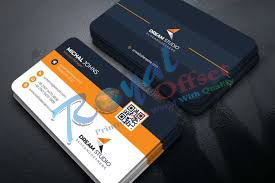
A Guide: How to choose the right paper for business cards
A business card is more than just a piece of paper—it’s a first impression, a branding tool, and a representation of your business. One of the key factors that determine the quality and feel of a business card is the paper it’s printed on. Choosing the right paper for your business cards can make a big difference in how people perceive your brand.
In this guide, we’ll break down everything you need to know about selecting the best paper for business cards, including paper types, finishes, thickness, and printing techniques.
1. Understanding Business Card Paper Types
Before selecting the right paper for your business card, it’s important to understand the different types of paper available.
a) Standard Cardstock
-
This is the most commonly used paper for business cards.
-
Typically ranges from 14pt to 16pt in thickness.
-
Affordable and available in a variety of finishes (matte, glossy, etc.).
-
Ideal for general business use where cost-effectiveness is a priority.
b) Premium Cardstock
-
Thicker than standard cardstock (18pt to 32pt).
-
Gives a luxurious feel and enhances brand perception.
-
Suitable for professionals, high-end brands, and industries where making an impression is crucial.
c) Textured Paper
-
Includes materials like linen, felt, and cotton paper.
-
Adds a unique tactile experience.
-
Best for creative industries, luxury brands, and businesses wanting a handcrafted feel.
d) Recycled Paper
-
Eco-friendly and made from recycled materials.
-
A great choice for brands that promote sustainability.
-
Can have a slightly rough texture, depending on the process used.
e) Plastic & Metal Cards
-
Alternative materials for businesses that want to stand out.
-
Waterproof and highly durable.
-
More expensive but provides an exclusive feel.
2. Choosing the Right Thickness for Business Cards
The thickness of a business card plays a crucial role in its durability and premium feel. Paper thickness is measured in points (pt) or gsm (grams per square meter).
-
14pt (Standard Thickness) – Thin, flexible, and cost-effective. Good for basic business needs.
-
16pt (Premium Standard) – A thicker and more durable option with a sturdy feel.
-
18pt to 32pt (Ultra-Thick) – Provides a luxurious feel. Best for industries where prestige matters (luxury brands, consultants, real estate).
-
100lb to 130lb Cover Stock – Measured in pounds, this range includes some of the most sturdy and premium card options.
Tip: If you want your business card to feel substantial and high-quality, opt for at least 16pt or thicker.
3. Business Card Finishes: Matte vs. Glossy vs. Textured
After selecting the paper type, the next step is choosing the right finish. The finish affects the look, feel, and durability of your business card.
a) Matte Finish
- Non-glossy, smooth texture.
- Gives a sophisticated and modern look.
- Ideal for professional, minimalist, and luxury brands.
- Doesn’t show fingerprints easily.
b) Glossy Finish
- Shiny and reflective surface.
- Enhances color vibrancy and detail.
- Works well for designs with bright colors and images.
- Can be prone to fingerprints and glare.
c) Soft-Touch (Velvet) Finish
- Feels smooth and velvety to the touch.
- Adds a luxurious and premium experience.
- Great for high-end brands and creative industries.
d) Textured Finishes (Linen, Embossed, etc.)
- Adds a unique feel (linen, felt, or handmade paper).
- Gives a sophisticated, artistic, or rustic appeal.
- Suitable for industries like fashion, design, and boutique businesses.
Tip: If you want a modern and clean look, go for matte. If you prefer something bold and attention-grabbing, choose glossy. For a premium feel, soft-touch is a great choice.
4. Special Printing Techniques to Enhance Your Business Cards
To make your business cards even more unique and eye-catching, you can opt for special printing techniques:
- Foil Stamping – Adds a metallic foil (gold, silver, or holographic) for a luxurious touch.
- Embossing/Debossing – Creates a raised or indented effect for a tactile feel.
- Spot UV Coating – Adds glossy highlights to certain areas, making them stand out.
- Edge Painting – Colors the edges of the card for a stylish and modern look.
These techniques can add a premium look to your business cards and help them stand out in a competitive market.
5. Choosing the Right Paper Based on Your Business Type
Different industries require different styles of business cards. Here are some recommendations based on your industry:
-
Corporate Professionals (Finance, Law, Consulting, etc.) – Matte or soft-touch finish on premium cardstock (16pt-18pt).
-
Creative & Design Industry – Textured paper, unique shapes, or embossing for an artistic touch.
-
Luxury Brands & High-End Businesses – Ultra-thick cards with foil stamping or edge painting.
-
Eco-Friendly & Sustainable Brands – Recycled paper with a natural finish.
-
Tech & Startups – Clean, modern designs on matte or soft-touch finishes.
Tip: Your business card should reflect your brand’s personality. Choose a paper type that aligns with your brand identity.
6. Final Tips for Selecting the Right Business Card Paper
- Consider durability – If you want your card to last longer, go for thicker paper (16pt or more).
- Match your branding – The card should reflect your industry, style, and professionalism.
- Think about practicality – Textured cards look great but may be harder to write on.
- Test samples – Many printing companies offer sample packs. Always feel the paper before ordering in bulk.
Choosing the right paper for your business cards is just as important as the design itself. The paper type, thickness, and finish all contribute to making a lasting impression.
Whether you’re going for classic matte, bold glossy, or premium soft-touch, the key is to select a paper that represents your brand’s values and stands out in a competitive market.
Which type of business card paper do you prefer? Let us know in the comments!
